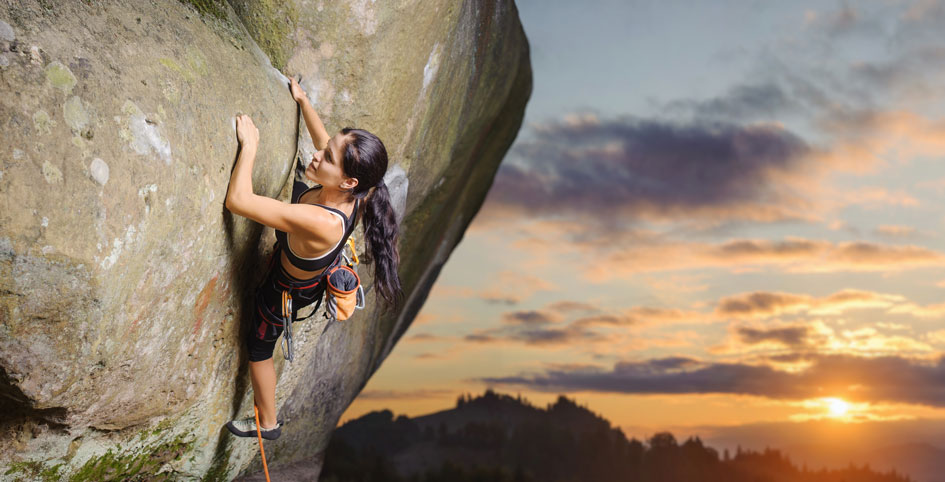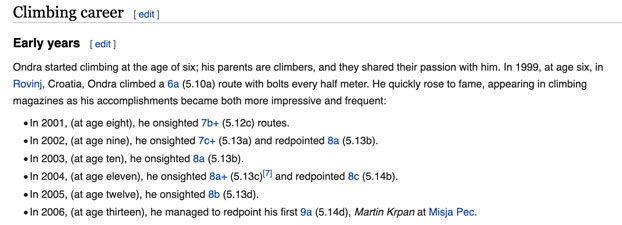If you’re new to climbing, you’ll be hearing a lot of new terms in the climbing gym as well as from videos that you might consume. A common climbing term you might run into is ‘an Onsight’. An example would be someone saying something along the lines of: ‘I can climb 7a on a good day but I can only onsight 6a.’
What does an Onsight mean in climbing? Let’s take a look…

What does Onsight mean?
An onsight is a climbing term used when a climber successfully ascents a route on their first try without any beta. The term speaks for itself really. Onsight means you climb the route on sight, with no prior information to help guide you.
An onsight only counts if two rules are met:
- You reach the top in your first try
- You don’t have any prior knowledge of the route (beta) before you start
This makes an onsight the most prestigious climbing term out there.
Other Climbing Terms Explained
| ‘Beta‘ explained |
| ‘send’ explained |
| ‘crux’ explained |
| ‘Flash’ explained |
| ‘Sandbag’ explained |
When does an onsight not count?
Climbing terms such as onsight are often cause for controversy. What one climber might consider an onsight, another climber would consider a flash.
Some (not many) climbers argue that during an onsight, you shouldn’t be allowed to inspect the wall in any way. This extreme form of policing the term ‘onsight’ would invalidate most onsighted routes. In reality, inspecting the route from the ground is considered to be fine.
The climbing community has found that if the rope is used in any way to benefit the climber (e.g. using the rope to rest), the send could no longer be considered an onsight.
Most climbers agree that during an onsight attempt, the climber attempting is not expected to place the quickdraws themselves. This can be done by the belayer beforehand.
Obviously, you cannot receive any information about the route before attempting an onsight.
To sum up, here’s what you can’t do during an onsight:
- You can’t study the route beforehand in any way
- Use the ropes to your advantage
- Have your partner chalk the route for you
- Touch the holds before your attempt
However you can:
- Have your partner set up the quickdraws
- Take a peek from the ground beforehand
What is the difference between a flash and an onsight?
The term ‘onsight’ is not to be confused with a similar climbing term called ‘flash’.
The only difference between an Onsight and a Flash is that during a flash the climber has already studied the route beforehand. Compared to an onsight, where the climber starts without the use of any beta.
What they have in common is that both climbing terms require the climber to ascent on their very first try.
For this reason, sometimes climbers will mix the two terms up.
While the term Flash is used in both sport climbing and bouldering, the term onsight is only used in outdoor sport climbing.
This is because in indoor gyms, the climber can already acknowledge a big part of the route by standing in front of it. Meaning that using the term ‘onsight’ wouldn’t be fair. Similarily, even outdoor boulderers will rarely refer to a first try ascent as an onsight. Instead they would call it a flash.
Why attempt an Onsight in climbing?
Climbers attempt onsights for the prestige that comes with it. Saying you can onsight a certain grade, proves that you have truly mastered said grade level.
For example, to acknowledge how much of a climbing prodigy Adam Ondra was in early childhood, on his Wikipedia page his early-career achievements are ranked in terms of onsights.

Just because you can ascent a 7b+ grade, doesn’t mean you have mastered it. By saying that Adam Ondra was able to onsight 7b+ at just 8 years old, proved that he had mastered that climbing grade.
Choosing between attempting an onsight and a flash is often a tough decision to make for professional climbers. This is because you only have one try. If you fail your onsight, you can never flash it and vice-versa.
In most cases, climbers will attempt to onsight routes after they have successfully flashed routes in the same grade range.
How to onsight a climbing route
As I mentioned earlier, being able to onsight a grade range establishes your mastery of said grade range. For this reason, you should not attempt to onsight any climbing grade that you cannot easily flash. Doing so will only set you up for disappointment.
So for example if you easily flash 6a, you can attempt to onsight a 6a. But if you struggle to flash 6b’s, you shouldn’t attempt an onsight.
Here are a couple of tips to help you successfully onsight your first route.
Make yourself aware of the rules
Nothing would be more disappointing that thinking you successfully performed an onsight, only to later find out that you messed up and forgot about a rule.
So before you attempt an onsight, make sure you know the rules. I’ve mentioned these earlier so scroll up or click the link.
Warm up beforehand
Before your onsight attempt, you should be properly warmed up. Not only will a good warmup help you prevent potential injuries, but it will also help you get to your peak performance.
In climbing, you aren’t performing at your best until your muscles have been properly warmed. This is why you’ll see experienced climbers do warmup excercices before they even get on the wall.
Ideally, your onsight should not be your first climb of the day. If you can, visit a climbing gym beforehand for a quick warm up session or climb an easier route to warm up.
Attempt your onsight
Before you hop on the wall, try to read the route as best as you can from the ground up. Doing so is acceptable during an onsight. You can utilize the chalk marks left behind by other climbers. These should help you figure out the different hand and foot holds and how they were used.
Being able to read the route onsight is something that only comes with vast climbing experience.
During your route reading you should also look for any possible rest points. Do you notice any jugs that you could take a break on? Taking rests is essential during onsights as you are expending more energy than usual.
The next skill that you should possess to become an onsight climber is climbing flow. Having flow means you aren’t wasting energy on unnecessary moves. Without proper flow, an onsight is impossible.
Flow requires you to move swiftly, but with precision. If you rush your onsight, you will likely fail. However, if you take too much time to read your route and make decisions, you will waste too much energy.
So the sum up, here are the skills you need to successfully onsight a route:
- (You should be able to flash the grade)
- Ability to read routes quickly
- Take rests where you can
- Climb with proper flow
These are skills that can be trained only by climbing a lot. You should acknowledge them during your gym training sessions. Next time you go climbing indoors, focus on route reading and climbing with proper flow.
The video below features an 8C+ onsight by Adam Ondra, in which he narrates the entire route and expresses his thoughts. The perfect video for any climber attempting their own first onsight delivered by the best climber in the world. What more could you want?
What is the hardest onsight route?
Currently, the hardest onsight route is graded 9a. Only two climbers have successfully onsighted this grade: Alex Megos and Adam Ondra.
On the 24th of March, 2013, Alex Megos accomplished the world’s first ever 9a onsight after he successfully onsighted Estado Critico at Siurana, Spain.
At the time, Alexander was only 19 years old. As documented by EpicTV Climbing Daily, Alex did not plan to onsight the route, it happened accidentally which makes it so much more impressive.
107 days after Alex Megos send the first 9a onsight in climbing history, Adam Ondra followed up with his own 9a onsight.
On July 9th, 2013, Adam Ondra successfully onsighted the world’s second-ever 9a route on Cabane au Canada at Rawyl, Switzerland.
According to himself, the route perfectly fit his style. He did not expect to onsight it as he expected the route to be dirty after the long winter but instead he stumbled upon a clean route, allowing his dream of onsighting his first 9a to finally become true. While he considers this route a soft 9a, he does believe it is in the 9a region and should not be downgraded.
Adam quickly followed up his first 9a onsight with a second one. On May 4th, 2014, Adam Ondra successfully onsighted Il Domani in Bilbao, Spain. He specifically saved this route for an onsight and it was definitely worth it. Adam considers this his hardest onsight.
The hardest female onsight accomplished is 8c by Janja Garnbret.
Janja Garnbret, an Olympic Medalist in Women’s sport climbing, marked the hardest female onsight on ‘Fish Eye’ in Oliana, Spain. The route is graded 8c (5.14b). Garnbret achieved the onsight on November of 2021 at age 22.
Before Janja, Josune Bereziartu held the highest female onsight record on 8b+.
Which climbers have onsighted 9a?
The following climbers have successfully onsighted 9a:
- Alex Megos (first ever 9a onsight & 2 total 9a onsights)
- Adam Ondra (second-ever 9a onsight & 3 total 9a onsights)
Which climbers have onsighted 9b?
Until today, no climber has successfully onsighted a 9b graded route.
Other notable onsights in climbing history
- Cabane au Canada (9a) – 2013
- Il domani (9a) – 2014
- Blanquita (8c+) – 2011
- Odin’s eye (8c+) – 2012
- Super Plafond (8c+) – 2014
- C’est la vie (8c+) – 2016
- Politicamente Corruptos (8c+) – 2017
- La Concepte Integrale (8c+) – 2017
- Estado Critico (9a) – 2013
- TCT (9a) – 2017
- Victimes del Passat (8c+)
- T-rex (8c+) – 2008
- Divine Fury (8c+) – 2008
- Humildes Pa’ Casa (8c+) – 2008
- French Gangster (8c+) – 2009
- Aitzol (8c) – 2011
- Avatar (8b) – 2015
- Maskoking (8b+)
- Eclipse Cerebral (8b)
- True Crime (8a)
- Geminis (8b+) – 2021
- Humildes pa casa (8b+) – 2021
- Gorilas en la Niebla (8b+) – 2021
- Fish eye (8c) – 2017
More articles like this
- Indoor Bouldering Basics: intro to gym climbing
- Tips for short climbers
- Complete Guide to Bouldering Grades (& conversions)
- How to start and finish a boulder problem
- Can I get abs from climbing?
- Bouldering vs rock climbing
- How often you should go bouldering per week
- Why bouldering is a good full-body workout
- Climbing 101: what is cutting feet?
- How long does it take to progress in bouldering?
- How much does it cost to start bouldering?
- What to wear indoor bouldering
- How much of a bouldering wall can you use?
- Should climbing shoes hurt?
- How many climbing shoes do you really need?
- Yoga for climbers
- Core workout for climbers
